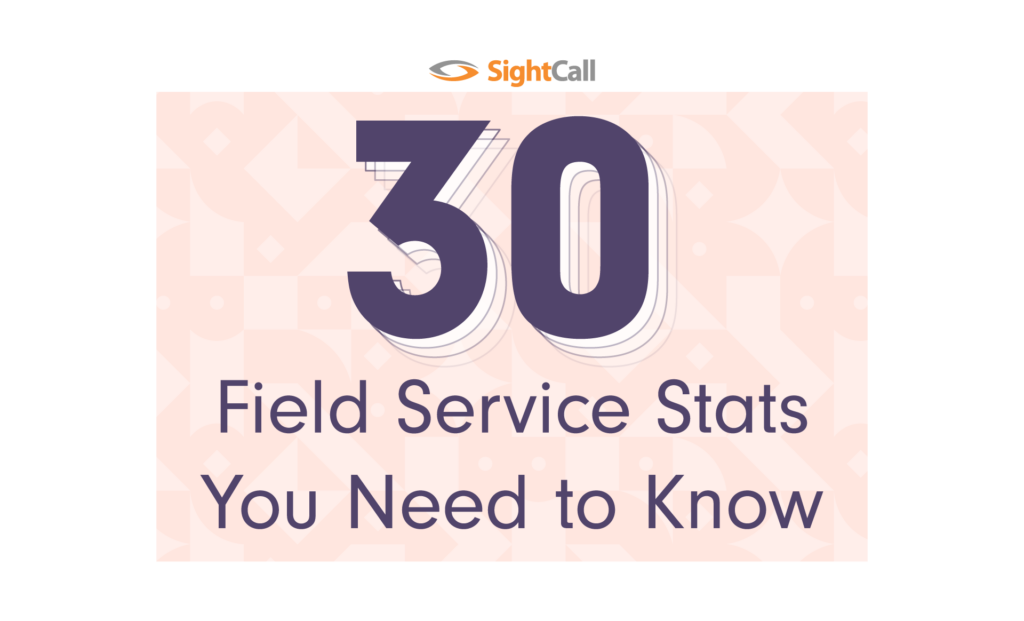Looking for the most current list?
The field service management market is forecast to grow at a CAGR of 11%. At this rate, the FSM market that has an estimated value of $3 billion in 2020 will reach $5.1 billion by 2025 (MarketandMarkets, 2020). In this time of rapid digital transformation, changing customer expectations, and the increasing complexity of products, equipment, and the services needed to support them here are 30 stats every FSO needs to know.
What are the biggest challenges facing field service organizations?
- Meeting Customer expectations – 56%
- Reduced profit Margins – 48%
- Getting quality technicians and drivers – 47%
- Scheduling and dispatching inefficiencies – 38%
- Competitive pressure – 34%
- Increasing complexity of services – 33%
(according to Verizon Connect, 2020)
The impact of COVID-19 has reshaped the entire service landscape, and supercharged the momentum for digital transformation.
- 78% of FSOs completely stopped deploying technicians to customer sites during the height of COVID-19. (TSIA, 2020)
- 55% of fleet managers and executives reported that the COVID-19 pandemic came with a negative business impact. (Verizon Connect, 2021)
- Amid the pandemic, 44% of fleet managers see increasing costs as their top challenge in this time of economic and regulatory uncertainty. (Verizon Connect, 2021)
- 50% of supply chain operators expect that recovery from COVID-19 will take at least six months. (McKinsey & Company, 2021)
Customer expectations are changing, with an emphasis on technology, self-service, and fast reliable support.
- 89% of customers want to see modern, on-demand technology applied to their technician scheduling, and nearly as many customers would be willing to pay a premium for it. (ReachOut, 2020)
- 75% of consumers don’t like the idea of having field technicians in their homes unless absolutely necessary. (CustomerThink, 2020)
- 90% of consumers identified customer service as a factor in deciding whether or not to do business with a company and 86% of buyers said they are willing to pay more for a great customer experience (Microsoft, 2020)
- by 2025 as many as 95% of customer interactions will be through channels supported by AI (Microsoft, 2020)
Field technicians need more skills and more access to shared knowledge and training to complete their tasks.
- 75% of field technicians report that products have become more complex and more knowledge, specifically more technical knowledge, is needed to perform their jobs now vs. when they started in field service (The Service Council, 2021)
- 70% said both customer and management demands have intensified (The Service Council, 2021)
Leaders agree that AI and AR Technology is important for the future of field service.
- FSOs believe AI will have the most impact on improving customer satisfaction (83.81%) within their organization. (Copperberg, 2021)
- The majority of FSOs (44.76%) are looking to deploy AI within the next 2-4 years, with some (17.14%) looking to deploy AI within the next 12 months and even (20%) looking to deploy immediately (Copperberg, 2021)
- The combination of mobility and artificial intelligence (AI) improve field service agent productivity by 30% to 40%. (ReachOut, 2020)
- 40% of field technicians believe technologies such as augmented reality (AR) and virtual reality (VR) are very helpful. (Copperberg, 2021)
The skills gap is widening, due to a combination of retiring experts, fewer incoming technicians, and long training times.
- The aging field service workforce poses a shortage of around two million workers. (ServicePower, 2020)
- 73% of service organizations identified the aging workforce as a potential threat to their field service organizations and 56% of those companies are implementing remote assistance technologies to help address it. (Field Service News, 2018)
- 47% of field service companies are still having trouble getting enough quality technicians and drivers to meet business goals (Verizon Connect, 2020)
- About 50% of field technicians and service workers are expected to resort to freelancing by 2025. (Azuga, 2020)
- 60% of Younger technicians, between the ages of 24 and 44 indicated that they may not stay in field service (The Service Council, 2021)
As IoT devices quickly gain popularity, customer and technician needs are changing to support them
- As of 2019, there were 42.2 million smart homes in the US. (Wonder, 2019)
- 73% of field management firms have already incorporated Internet of Things (IoT) into their operations. (ReachOut, 2020)
- Experts estimate that there will be 35 billion IoT devices installed worldwide by the end of 2021. (Security Today, 2020)
- The value of growth brought about by IoT apps as utilized in the field service industry increases by $470 billion annually. (ReachOut, 2020)
Remote visual support has been shown to improve productivity, shorten training times, help address skills gaps, and increase customer and technician satisfaction.
- About 75% of field service businesses that utilize mobility tools have observed increased employee productivity, while the rest have seen customer satisfaction rates rise. (ISE, 2020)
- 77% of FSOs invest in technology and solutions geared towards information enablement. (ServicePower, 2020)
- Remote support can solve issues up to five days earlier (Forrester, 2021)
- Using remote support technology has improved on-the-job training and decreased the time to train new technicians by an average of 41% (SightCall, 2020)
- Video support is already being deployed by over 50% of field service organizations to help technicians perform their jobs more effectively (Copperberg, 2021)



